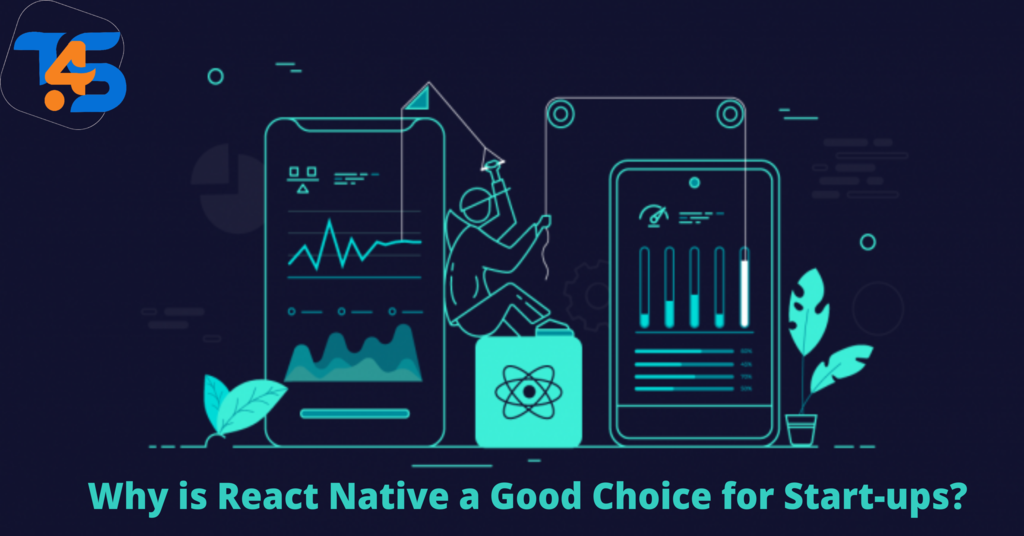
Why is React Native a Good Choice for Start-ups?
The world is turning into a digital hub with smartphones, their introduction has made our lives enjoyable. Mobile apps are making their ways into our lives and have become a primary source of information and data about almost anything, without having to spend in a significant amount of time. It is important to be aware of the importance and value of mobile applications in our lives.
The modern day startup process is like driving a sports vehicle. It's fun, thrilling and quick, but it demands some smart decisions. You have no choice but to make mistakes, and the risk is extremely high. In the end, there are the possibility that you will be running out of fuel or crash the vehicle prior to reaching its final destination. To avoid this, it is important to focus on picking the appropriate material that is best suited to your requirements.
Frameworks that support cross-platform development allow developers to develop applications that work on multiple platforms with one codebase. This method is currently used by the majority of the businesses because it allows them to develop applications that are cost-effective. Simply put cross-platform development allows businesses to invest in mobile app development at one time and work on it in a single team. Today, React Native is in trend and businesses have begun using React Native app development to offer value-based services to their users.
WHAT IS REACT NATIVE?
React Native was launched as an open source framework to support mobile and web app development. It lets developers create cross-platform apps that run on Android, iOS, or Windows with a single codebase. Since the same codebase can be used to develop applications that run on multiple devices, it helps reduce the amount of resources required and the time required to launch. If we look at it in more technical terms React Native is an open source JavaScript framework that is based on JS and comes with the ReactJS library to create appealing UI. A majority of developers use React Native for creating robust web and mobile applications since it provides many of the top-of-the-line features.
In this age of digital competition, the necessity of developing specific applications using React Native has become a top priority. Companies are now focused on cutting down on development costs and resources to ensure rapid development and maximum performance. With the development of hybrid mobile applications using Xamarin, React Native, and Ionic making their way into the marketplace, designers are searching for ways to develop one application that can be used on different platforms, and with an attractive user interface.
NATIVE VS. REACT NATIVE DEVELOPMENT: THE DIFFERENCE FOR START-UPS
Developers see native app development to be the most classic and tested method of developing mobile apps. When it comes to hybrid mobile application development, it comes with certain disadvantages that are significant, such as the slow performance in comparison to native application development.
Through React Native, app developers are able to provide native-like feel and performance, while reducing development time and expense. If RN could have been better then native on every way, it could have been the most popular platform for mobile app development. However, this hasn't happened until today. So, let's examine some of the distinctions.
Native Functionality
It is true that the community of React Native isn't nearly as large than that of the Native one. It is because developers are unable to make use of some third-party APIs or libraries that can only be used in the native user interface. This is the same for the capabilities available on native devices. However, native app developers are able to integrate certain features within the application, React Native developers must wait for the feature to be made available for the React Native.
Even if your application relies on third-party components, or APIs that aren't currently available in React Native, developers can make use of them in their applications. To do this, developers need to develop some unique modules referred to as "bridges" with Kotlin or Java. By doing this, the native code and JS code are able to communicate with one another.
Cross-Platform Development
React Native is the leader of this class because developers are unable to create apps that work on multiple platforms using the same codebase. Through the native app development process, it is possible to develop apps designed for iOS and Android even if they're completely similar to one another, think of the process as developing applications for two distinct platforms.
With RN developers are able to develop a single codebase. And approximately 95% of the same code is used for developing applications for iOS as well as Android. But, in some cases, developers will need to write between 20% and 25 percent native code for the integration of features such as native UI components like push notifications, deep linking and more. However, this will take less time than creating an app completely from scratch.
Start-ups that are looking to launch their MVP of their app for the two platforms of iOS and Android developing apps for cross-platform platforms is the ideal option. Most start-ups have limited funds and resources; therefore they are forced to select a single platform to test their app. However, with RN they can choose to use both platforms within the budget of a small one. Furthermore, if you decide to build the application on one platform, you could later expand your application using the RN.
UI/UX
In the case of native app development, it is necessary to use specific patterns of design for your platform for example (animations buttons, dates pickers and so on.). The native communities of iOS and Android provide more relevant libraries. However, with RN is that an advantage? Most likely, if you need to access to certain libraries. It is, however, difficult to deal with this situation in reality when you have to use the library you want but you don't need the libraries that are provided through React Native.
There are times when for RN developers, it's difficult to create complex UI elements like animations. Therefore, RN is often regarded as the most suitable choice for the creation of MVP of projects because they do don't require complex UX/UI design components or designs.
Since the components used by Rn are the same as native applications, RN apps also offer the similar UI user experience. For the majority of the apps, you can get the similar user interfaces to native apps. Also, it is worth considering RN when you need your app to appear identical across the iOS and Android platforms. While it's challenging to native developers however, the RN team for app development is able to easily maintain the same design and style across the two platforms. From a development perspective, who will win is definitely React Native. To summarize the following are the most significant differences in UI development:
1. The development procedure follows the imperative approach for programming. The developers must define the entire sequence of actions that will determine that will determine how the user interface of the app is created.
2. RN developers use the declarative approach to programming. Developers only need to specify what should be done, without having to define an exact procedure.
In the end, RN developers are able to develop an application using smaller and less complicated code, and be able to easily maintain the app.
Performance
Performance is among the most essential aspects of any technology or framework. For developers who aren't familiar with RN might believe that applications created with RN are not performing well since they're created in JavaScript.
Additionally, rewriting an application using React native can help developers work quickly. What are the potential problems with using the React Native framework and how they can be overcome? Here are some suggestions to help you:
Speed
When working using RN developer, you will be a more cautious than native developers. When working with RN it's easy to make errors that could cause the application to run slower or even stop working. However, if you've got everything correctly, it could not cause any issues for you. If the apps aren't too big in size, the problems aren't noticeable however, when the app's size grows the possibility of a problem. This can lead to an additional issue.
Application Size
Since RN applications depend on libraries, APIs and APIs from third parties along with native UI components Utilizing excessive amounts of these elements can make the application quite heavy. If you're developing an RN application that uses native apps, this feature is used as an extension. Thus, your RN application will include the capabilities of native apps and the RN engine that is integrated into JS code. This means that the logic of an RN application won't be less than native apps. So what can we do to address this issue? Here's the answer that might assist:
1. Transform bitmap images to vector images
2. Ensure that the compression is done for graphics and images
3. To install Android apps, you can make use of Android App Bundle
4. Conversion JSON information into static IDs for objects
5. Optimization of libraries native to the country
Navigation Between Lists and Screens
Navigation is usually not thought of as a concern as such, but rather an element of your product, in which there are some problems in the JS component. The problem is that JavaScript is unable to execute multiple actions at once. Instead, they're performed each one at a time. This is why the navigation between screens is wait in the sequence when there are other tasks that are taking place. When animating, the following method could be utilized:
The user makes an action in the native interface. The request is transmitted to React Native. React Native side, where it's transformed into an "do this"-kind instructions. When it's returned the action is executed on React Native.
This is one of the primary reasons some RN applications have issues when performing operations, particularly when running navigations or animations. The issue with lists is the same as that of navigation. Therefore, putting too many items to the same list can result in performance slowdowns.
Updates
Although it may be about moving a button by a just a few pixels, in native applications, the developers need to create the whole app. It's time-consuming, and the larger the app will be, the more time developers will require.
Additionally, before putting the app available before it is available on Google as well as the Apple apps, the business must first test the app to make sure it does not violate the rules of the app store or rules. It could take some time.
But that's not the only thing! After the app has been accepted with the latest version, some users might take more than a couple of days to update their application. It's because they didn't receive the update, or they didn't install it following the release.
However, with RN there's no comparable system. The updates are released in the air, and when developers make changes to their JS code, the changes are immediately visible for the programmers to see. Similar to the websites.
The React Native framework is regarded as an ideal option for testing A/B and you can find six bugs, even before users are aware of they are noticed. If you discover a problem within a few hours of launch of the project, you can quickly fix it using React Native.
WHEN REACT NATIVE APP DEVELOPMENT SHOULD BE CONSIDERED?
The choice of the right most suitable technology for mobile app development isn't an easy job however, with pre-defined objectives, budget estimates and a budget, it's easy. So here are some scenarios where React Native should can be considered the best option:
Native Apps
If your business already has an iPhone or Android application that you use for your business it is not necessary to write completely new application using React Native. It is easy to move your application using the code base you have previously used.
Quick Scaling
It's simple to hire React native developers, and firms that develop apps can quickly expand their teams.
Create MVP
It's not enough to simply have an idea for the project. You need to conduct a extensive market research in order to build the MVP as quickly as you can.
Tight Deadlines
If you're a new business it is imperative to be fast, as fast as Need-for-Speed, or even more fast. All depends on MVP It is also important to be thinking about periodic updates and making regular adjustments.
Limited Budget
At a minimum, you should have an MVP. However, it is possible that you have to cut your budget even before you've finished the project. By using React native you will be able to reduce the chance of running out of your budget.
BENEFITS OF REACT NATIVE FOR START-UPS
When making decisions that affect your life it is important to consider what are the negatives and advantages of the option you make. To aid you in this we've created the following list advantages from React native from a business and technical perspectives:
The Benefits of Business Perspective
Excellent User Experience
The effectiveness of every digital product is dependent on the experience of its users. In terms of technicalities, React Native app is in essence an app that is not "the app", however it appears and feels the similar to. It is this because it's fully responsive.
Stability and Evolvement
Since its introduction, React Native is still growing and supported by a massive community backing. Since it is able to solve many of the issues and is completely risk-free of using it.
Developers Availability
React Native isn't an entirely new technology for developers and most people are already acquainted with it. Furthermore, the market for React Native is robust. You can hire freelance developers through UpWork or employ developers through an agency.
Quick Time to Market
Time is money as is time. The sky's the limit. It is not advisable to invest months creating an app without presenting it to potential customers or users. When compared to native application development, using React Native developers can speed the process of development up to 50 percent. This allows start-ups to develop an MVP two times as fast.
Money Savings
This aspect is directly linked to the earlier points. It is clear that making a single hybrid app rather than two distinct apps that run on Android or iOS is much more affordable and economical for businesses.
Time Savings
Thanks to React Native, developers can easily develop applications for multiple platforms from the same codebase. This greatly simplifies the development process and also the time it takes for developers.
Benefits from a Technical Perspective
Compatible with Back-End Technologies
React Native is able to easily be integrated with back-end frameworks like Ruby on Rails as well as Django.
Declarative Style
It's all about what you want to do, but in an opposite to imperative fashion and how you'd like to accomplish it. For instance, let's say that you have hired an executive chef to have a lavish dinner at your home. In lieu of telling the chef how to make it happen (imperative style) instead, you simply state what you'd like to have (declarative manner), i.e. "Make me Hawaii pizza, please."
When using React Native, it is not about WHAT you'd like to go about it however, it's about what you would like to accomplish it in different ways. For better understanding, let us take an example. Imagine you have hired an exclusive chef to prepare an elegant dinner in your home. Instead of instructing them what to proceed (imperative style) it is your job to give them the instructions you would like (declarative manner).
Dynamic Development
Since its inception, React Native evolved in both the technical as well as the support for communities. This constant development clearly demonstrates two things:
- The first reason is that RN has more security for future use when compared to other frameworks.
- The second option is to easily employ a development team to assist with RN apps development.
Hot Reloading
This feature allows developers to monitor changes made to the application even if the application is running and running. Its Hot Reloading feature speeds up the development process because the application can be loaded in a timely manner.
Open-Source Community
If you're stuck in the process of development You can get assistance via Reddit or GitHub there is a support group which can assist you.
Reusable Components
Why write code over and over again when the same code could be reused. The identical code can be utilized for each of iOS and Android and each component can be updated within one place. This feature makes it's easy to create changes to the app.
Third-Party Extensions Support
In simple phrases, React Native is all about making development faster. Developers are also able to use third-party frameworks, plugins and frameworks like NativeBase as well as Galio to create native-looking applications as also the user interface for the component.
CONCLUSION
Now, you be aware that React Native is an open-source web-based application development platform that is backed by a huge group of developers. You've also witnessed the advantages start-ups can reap from React Native mobile app development. Therefore, if you're planning to create an app that will run on several platforms, don't look at another framework other than React Native. Since React Native has multiple benefits to offer, don't spend a moment to find a React Native app development company and start the process of developing.




